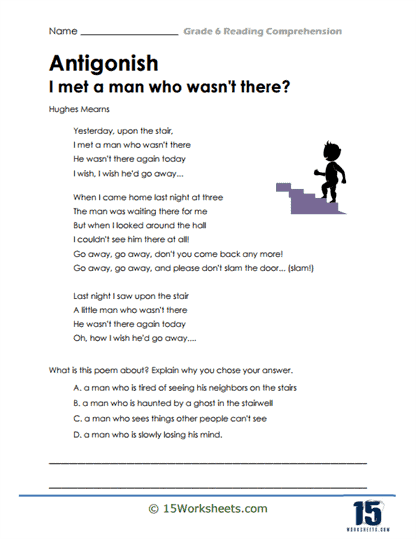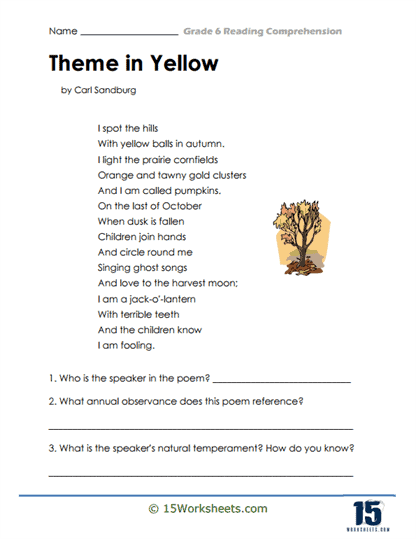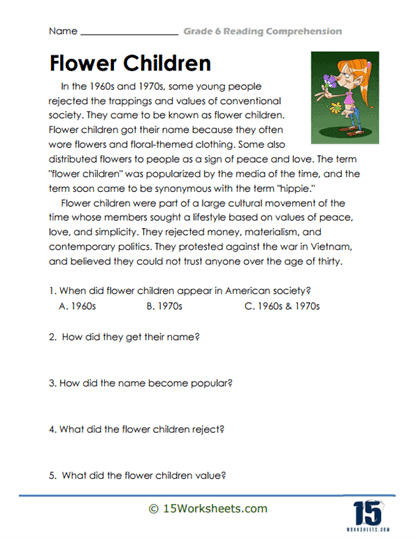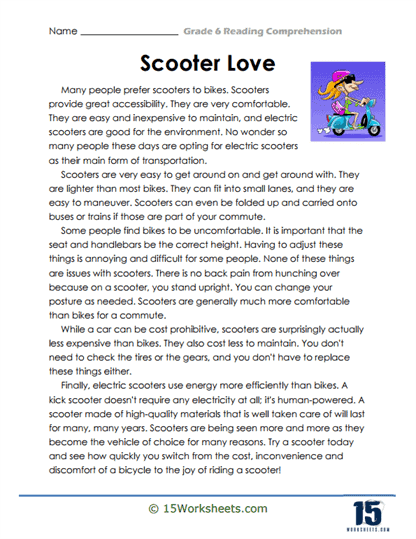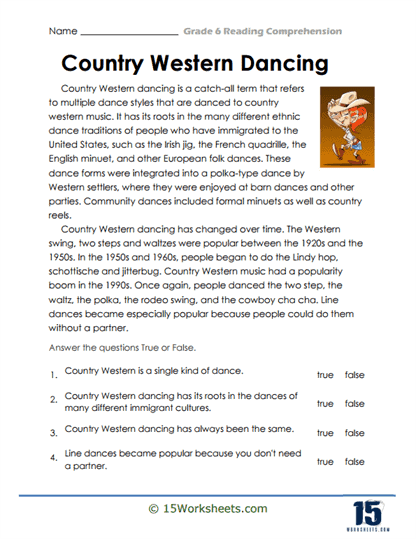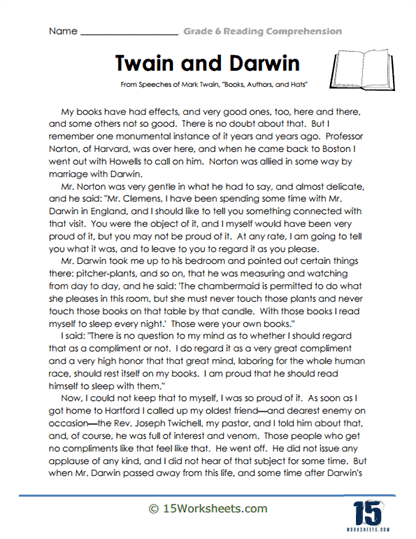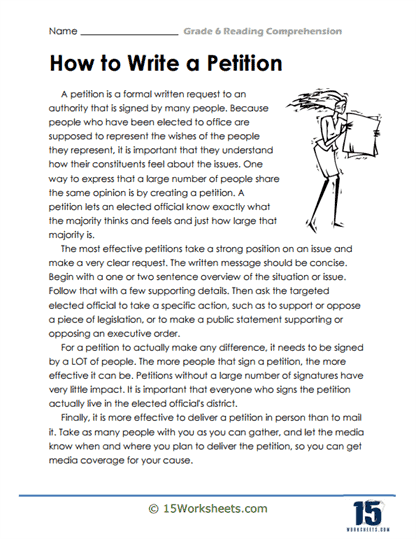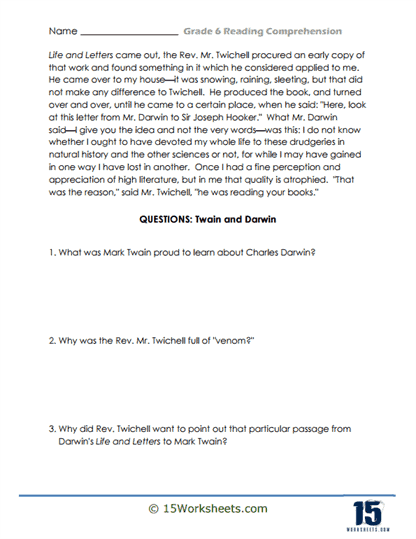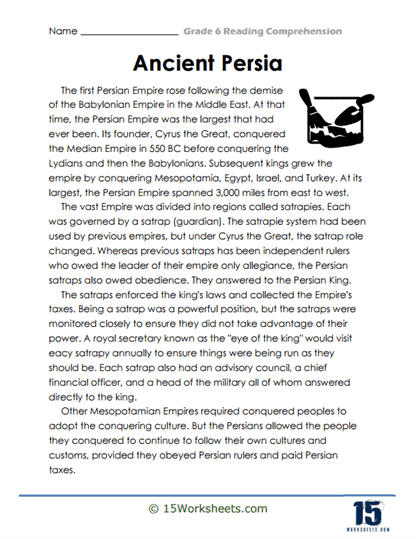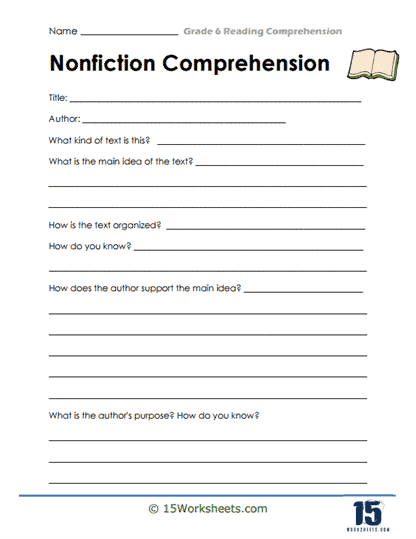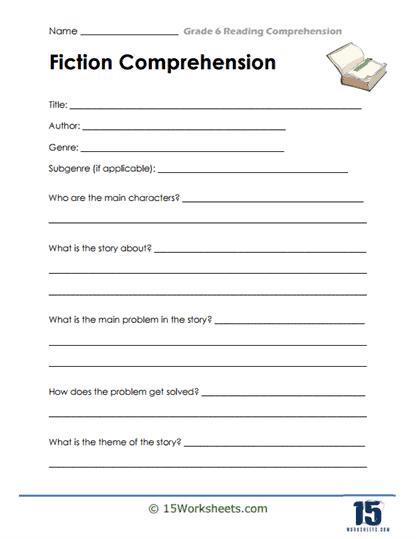Grade 6 Reading Comprehension Worksheets
All About These 15 Worksheets
These 6th grade reading worksheets are designed to help students enhance their comprehension skills. They contain a variety of reading passages, texts, and accompanying questions that aim to improve students’ understanding, critical thinking, and interpretation of written material.
We have a wide variety activities in this series. You will find all of these skills across each of the worksheets:
Reading Passages – These worksheets provide a range of passages, including fiction, non-fiction, poetry, and informational texts. The passages cover various topics, such as history, science, literature, current events, and more. The length and complexity of the passages are typically suitable for your grade level.
Comprehension Questions – Following each reading passage, there will be a set of questions designed to assess your understanding of the text. These questions may include multiple-choice, short-answer, or open-ended questions. They will require you to recall specific details, infer meaning, analyze the author’s purpose, make connections, and draw conclusions.
Vocabulary Development – Grade 6 reading comprehension worksheets often focus on expanding your vocabulary. They may introduce new words within the context of the reading passages and provide definitions or context clues to help you understand their meanings. Engaging with these worksheets will help you build your word knowledge and improve your overall reading comprehension.
Critical Thinking and Inference – The questions in these worksheets are designed to develop your critical thinking skills. You will be asked to make inferences, interpret information, analyze cause-and-effect relationships, identify main ideas and supporting details, and draw conclusions. These activities encourage you to think beyond the text and develop higher-order thinking skills.
Textual Analysis – As you progress through the worksheets, you will encounter passages that require you to analyze the author’s tone, style, and point of view. You will learn to identify literary devices, such as similes, metaphors, and personification, and understand how they contribute to the overall meaning of the text. This analysis helps you develop a deeper understanding of literature and enhances your ability to critically engage with different types of writing.
What Reading Skills Should A 6th Grader Have?
By the time students reach the 6th grade, they should have developed a range of reading skills that allow them to understand, analyze, and interpret more complex texts across a variety of genres. Here are some of the reading skills that a 6th grader should ideally have:
Vocabulary Expansion – They should have an expanding academic vocabulary and be able to figure out the meaning of words based on context clues, prefixes, suffixes, and root words.
Comprehension – They should be able to comprehend complex narrative and informational texts. This involves understanding the main ideas, supporting details, inferences, and overall message or theme of the text.
Analyzing Text – They should be able to analyze how a particular sentence, paragraph, or section fits into the overall structure of a text and contributes to the development of ideas. This includes understanding elements like foreshadowing, symbolism, and irony.
Compare and Contrast – They should be able to compare and contrast the experience of reading a story, drama, or poem to listening to or viewing an audio, video, or live version of the text.
Critical Thinking – Students should be able to critically evaluate the text, identify the author’s point of view, and recognize any potential bias. They should be able to formulate their own ideas and responses to the text.
Reading Fluency – They should read grade-level text with appropriate speed, accuracy, and proper expression.
Citing Evidence – When answering questions about a text, they should be able to cite textual evidence to support their analysis of what the text says explicitly as well as inferences drawn from the text.
Understanding Different Genres – They should be able to understand and interpret different genres of texts such as fiction, non-fiction, biographies, poetry, drama, and more.
Using Multiple Sources – They should be able to integrate information from several texts on the same topic in order to write or speak about the subject knowledgeably.
Recognizing Theme – Students should be able to determine a theme or central idea of a text and how it is conveyed through particular details; provide a summary of the text distinct from personal opinions or judgments.
A grade 6 student should be able to fluently read and comprehend a diverse range of texts, from fiction to informational pieces. They should possess an evolving vocabulary, utilizing context clues, and affixes to discern the meanings of unfamiliar words. Students should be adept at identifying the central idea of a text, supporting details, and understanding how these elements interrelate. Analytical skills are crucial; students should recognize the use of literary devices such as foreshadowing, metaphor, and irony. They should be able to determine an author’s point of view or purpose in a text and distinguish factual statements from opinions. Students in 6th grade should be capable of drawing on specific textual evidence to support both their interpretations and their personal responses.
These are general guidelines and some students may be ahead in some areas while needing further development in others. If a student is struggling with any of these skills, additional support and practice can be helpful.
A 6th grade student can bolster reading comprehension by setting clear purposes for reading, whether it’s to understand a concept, answer questions, or enjoy a story. They should practice annotating texts, making notes on key ideas, questions, or unfamiliar vocabulary, to engage actively with the material. Reading aloud occasionally can help in solidifying understanding and enhancing fluency. It’s beneficial to summarize each section or chapter, either verbally or in writing, to ensure they’ve grasped the main points. Engaging in discussions, either with peers or adults, about what they’ve read can offer alternative perspectives and deepen comprehension. Utilizing tools like graphic organizers or online resources can further aid in breaking down complex ideas, making connections, and reinforcing understanding.


